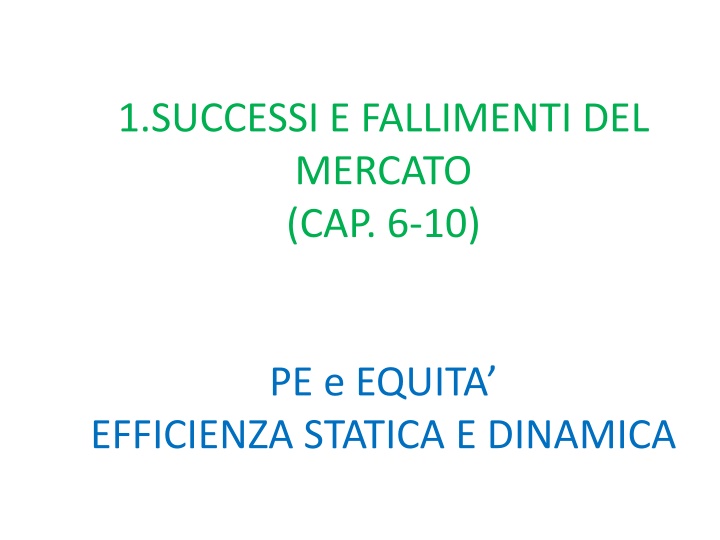
Market Successes and Failures: Insights on Efficiency and Dynamics
Explore the dynamics of market successes and failures within chapters 6-10, delving into concepts such as static and dynamic efficiency, Coase's theorem, public goods, common pool resources, and positional goods. Gain insights on the market's intricacies and discover solutions to market failures.
Download Presentation

Please find below an Image/Link to download the presentation.
The content on the website is provided AS IS for your information and personal use only. It may not be sold, licensed, or shared on other websites without obtaining consent from the author. If you encounter any issues during the download, it is possible that the publisher has removed the file from their server.
You are allowed to download the files provided on this website for personal or commercial use, subject to the condition that they are used lawfully. All files are the property of their respective owners.
The content on the website is provided AS IS for your information and personal use only. It may not be sold, licensed, or shared on other websites without obtaining consent from the author.
E N D
Presentation Transcript
1.SUCCESSI E FALLIMENTI DEL MERCATO (CAP. 6-10) PE e EQUITA EFFICIENZA STATICA E DINAMICA
Point (Th di Coase): K formato da un mix di istituzioni teoria del second best Es. innovazione e brevetti (*CAP. 2) trade-off efficienza statica e dinamica (*Schumpeter distruzione creatrice) tragedia degli anti-commons (1995)
2.BENI PUBBLICI (nn escludibilit free-riding) beni pubblici puri nn rivalit (MC=0) beni comuni rivalit (*CAP. 4)
BENI PUBBLICI PURI STATO MINIMO (difesa; ordine pubblico: polizia e tribunali) + scuola, sanit , acqua? BENI COMUNI COMUNITA (PREF. E NORME SOCIALI) * PROPRIETA INTELLETTUALE TRAGEDIA DEGLI ANTI-COMMONS (1995) (PESCA vs CONOSCENZA)
3. BENI POSIZIONALI (*Veblen, status, prestigio, potere, etc.) Beni privati (+, 0) Beni pubblici (+, +) Mali pubblici (-, -) Beni posizionali (+, -)
Scarsit socialeeccesso di competizione (es. Corsa agli armamenti, Coda del pavone) Poche soluzioni.. ..fenomeni spiegati: Si lavora di pi dove c pi diseguaglianza (USA) L aumento del PIL nn porta necessariamente a > felicit (USA)
4. FALLIMENTI DEL MERCATO E SOLUZIONI (TASSONOMIA)
*IMPOSTAZIONE TRADIZIONALE: prima mercati perfetti (EEG) e poi i fallimenti come casi particolari IMPOSTAZIONE DEL LIBRO: prima i fallimenti poi la concorrenza perfetta (nel mercato dei beni) come caso particolare CAP. 11: mkt del credito, il prezzo i fallimenti, contratti incompleti (POA), asimmetria informativa (MH e AS)
UNIT 10. MARKETS, CONTRACTS AND INFORMATION Courtesy of US Coastguard
T10.1 Negative production external effects A factory is situated next to a dormitory for nurses who work night shifts. The factory produces 120 units of humanoid robots a day. The production process is rather noisy, and the nurses often complain that their sleep is disturbed. The following graph depicts the MPC and MSC of the robot factory production. The robot market is competitive and the market price is 340. Based on this information, which of the following statements is correct? Select one answer a. The efficient level of output is 120 where the factory is profit-maximising. b. The efficient level of output is 0 where there is zero marginal external cost to the nurses. c. At Q = 120 both the factory and the nurses would benefit from the nurses paying a fee less than 120 to the factory to reduce output. Section 10.1 d. At Q = 80 both the factory and the nurses would benefit from the factory paying a fee less than 80 to the nurses to increase output.
T10.2 Bargaining and negative external effects The following graph depicts the MPC and MSC of the robot factory production. The robot market is competitive and the market price is 340. The local authority has now passed a law that ensures that the nurses have the right to undisturbed sleep (meaning zero production). Based on this information, which of the following statements are correct? Select all correct answers a. The Pareto efficient output is 80. b. The nurses minimum acceptable payment from the factory to produce the efficient outcome is 4,000. c. The maximum that the factory is willing to pay to increase the output to the efficient level is 6,400. Section 10.2 d. The net social gain from attaining the efficient output level is 9,600.
T10.3 Enforced compensation Consider again the factory and the nurses. Instead of the Pigouvian tax, the government is now considering implementing an enforced compensation from the factory to the nurses for the costs imposed. Based on this information, which of the following statements is correct? Select one answer a. The factory s marginal private cost now equals the marginal social cost. b. The total compensation paid will be 6,400. c. The nurses are worse off than they would be under the Pigouvian tax. Section 10.3 d. The factory s profit would be the same as under the Pigouvian tax.






















